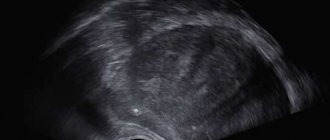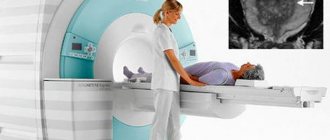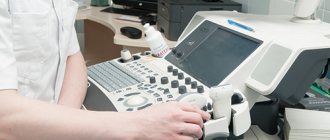Just a few decades ago, ultrasound was considered an auxiliary technique in the diagnosis of prostate diseases.
Nowadays, progress in the miniaturization of medical equipment opens up many new opportunities.
Transrectal examination has very great diagnostic value.
This is TRUS of
the prostate gland
, the reliability of the data obtained depends on proper
preparation for
it.
The principle of ultrasound diagnostics is that ultra-high frequency sound waves are applied to the prostate.
They are reflected from the organ itself and from its structures.
A special sensor emits and records reflected sound vibrations.
And a complex computerized system interprets them into a visual picture.
The prostate is located quite inconveniently for a routine cutaneous procedure.
A very small part of this small but important gland is adjacent to the perineum.
To get a more complete picture of its condition, it is necessary to connect the emitter and recorder of ultrasonic waves from the inside.
This problem is solved by special cylindrical sensors.
It is easy to pass them through the anus and bring them to the place of interest.
Ultrasound waves easily pass through the thin wall of the rectum, and the entire prostate becomes accessible to examination.
Transrectal and transabdominal ultrasound of the prostate
Ultrasound of the prostate gland transabdominally allows you to most comfortably, painlessly and quickly assess the condition of the organ components without any special preliminary preparation.
The transabdominal method is quite informative as a screening and preventive diagnosis; for a substantive examination it is used only in combination with transrectal ultrasound. This is caused by a large amount of interference coming from neighboring organs, a thick abdominal wall with sometimes an excessive layer of fat, through which it is necessary to “see” the structure of the tissues.
A more modern and high-quality technique is transrectal ultrasound of the prostate gland. It is performed through the rectum, the prostate is separated from the ultrasound probe only by a thin layer of connective tissue and the intestinal wall, which ensures extreme accuracy and purity of the signal.
Of course, the procedure may involve minor physical discomfort, but the value and accuracy of transrectal prostate ultrasound make it indispensable for identifying and treating reproductive system disorders.
What the study shows
By performing an ultrasound, you can clearly see the size, shape, density, contours and general condition of the prostate. If they are changed and disturbed, this indicates that there is a disease. It is diagnosed taking into account what TRUS of the prostate shows, and this can be:
- changes in tissue structure;
- blurred, unclear contours;
- impaired blood supply;
- stones and cysts;
- increase or decrease in size;
- tumor;
- inflammation.
How to prepare for a prostate ultrasound
Preparing for a prostate ultrasound usually does not represent any difficult task and is determined by the method of performing the procedure.
If traditional or transabdominal ultrasound of the prostate gland has become the method of choice, preparation will only consist of the need to come to the appointment with an unemptied bladder.
This will allow you to adequately assess the shape and structure of tissues through the stretched, even membranes of the bladder. It is important to note that the patient should not feel significant discomfort; a too tight condition and stretching of the bladder will only create interference.
With this type of prostate ultrasound, preparation consists of abstaining from going to the toilet several hours before the examination with reasonable fluid intake.
Let us mention how to prepare for an ultrasound of the prostate gland using the transrectal method, in which the examination is performed with a sensor in the man’s rectum.
- A few days before the diagnosis, it is necessary to stop taking laxatives or strengthening substances, foods that increase gas formation (legumes, flour products, carbonated drinks, cabbage and some other components of the diet)
- On the day of the ultrasound, in the morning and the night before, it is necessary to perform a bowel movement using an enema. It would not be amiss to remind you of the importance of the hygienic condition of the gluteal area
Indications for abdominal examination and diseases detected with its help

The indications for abdominal ultrasound are the same as for other methods of studying this organ:
- dysuric phenomena;
- various pain sensations;
- blood impurities in semen;
- inflammatory processes in secretory secretions from the prostate gland;
- spermatorrhea, prostatorrhea and other discharge from the urinary canal;
- premature cases of ejaculation;
- the age of a man after 40 years.
At the same time, doctors include frequent and small urination, difficulty urinating, incontinence or retention of urine as dysuric manifestations. Pain syndromes are important for a urologist if they are localized in the lower abdomen of a man, are felt in the scrotum or perineum, radiate sharp pain to the tailbone or sacrum, occur during periods of urination or during sexual relations or ejaculation.
With this method of examining a man, changes in the size of the prostate gland are easily detected, both in the direction of increase and decrease, unevenness of its contour, as well as blurred boundaries of the capsule, calcifications or other compactions are detected, swelling, the presence of stones, and deformation of the prostatic canal are visualized urination, hardening and enlargement of the seminal vesicles, as well as any atypical bladder condition.
When these changes are detected, specialists study the medical history in detail and can make a diagnosis of chronic prostatitis or prostatitis in the acute stage, vesiculitis, sclerosis, and prostate cancer.
How to do an ultrasound of the prostate gland
How a prostate ultrasound is performed is determined by the preferred method of inserting the probe.
With traditional transabdominal ultrasound:
- The patient assumes a lying position, after which the sensitive component of the device is applied to his stomach
- A layer of sliding gel is necessarily applied between the sensor head and the skin, which improves signal reception and prevents its distortion
- During an ultrasound of the prostate in men, sometimes a change in body position or a change in the degree of bladder filling is required
Many patients are concerned about how transrectal prostate ultrasound is performed.
This type of ultrasound involves the insertion of a thin and long sensor through the anus; the sensor is covered with a special gel and sterile film. The examination is safe and practically does not cause significant discomfort, although it may be accompanied by certain unusual sensations.
Most often, both types of ultrasound are used in combination to determine a reliable picture of the existing process.
General recommendations
Patients who wish to undergo an ultrasound examination should fast for approximately 8 hours before the examination.
It is recommended to conduct the study on an empty stomach. If this is difficult for you to do or you have diabetes, then on the morning of the examination you are allowed to eat a small piece of boiled meat or drink half a glass of sweet, weak tea. Eating fatty, spicy and fried foods, as well as strong coffee and tea, leads to contraction and poor visualization of the gallbladder. 1-2 days before the test, it is advisable to exclude from the diet foods that contribute to intestinal gas formation (fresh fruits and vegetables, dairy products, brown bread, carbonated water and beer).
If you are prone to flatulence (bloating), it is advisable to take enterosorbents (activated carbon, enterosgel, etc.) for several days.
It is advisable to refrain from smoking for 1.5-2 hours, which increases intestinal motility. It is unacceptable to perform a gastroscopy or colonoscopy before an ultrasound examination. It is necessary to take with you documentation of inpatient and outpatient examinations and treatment in the previous period. These data will allow you to evaluate the dynamics of treatment.
If you are prescribed an interventional procedure under ultrasound control, you must have recent (no more than 1 month) results of a blood test for coagulation (coagulogram), an analysis of the blood group and Rh factor on separate forms (stamping in the passport is not accepted).
Norm or pathology. Correct interpretation of prostate ultrasound is very important
The result of the study depends both on the quality of the diagnostic apparatus and on the qualifications of the specialist. Interpretation of prostate ultrasound will bring tangible benefits only when performed by a doctor who works closely with urological pathology and is familiar with both common and rare diseases.
Unlike magnetic resonance, computed tomography, and x-ray methods, ultrasound diagnostics requires active actions by the doctor. He places sensors in certain anatomical zones, selects the frequency, penetration depth and other signal characteristics required in each case, and actively interprets the data.
It is noteworthy that with an ultrasound of the prostate gland, a full interpretation of the results is available only to the doctor who performed the procedure itself.
According to the results of an ultrasound scan of the prostate gland, the norm (or, more precisely, the absence of pathological changes) is confirmed only with the reliable exclusion of violations of the structure, shape of the organ, and the absence of stones and neoplasms. Only a specialist who is confident in his knowledge and skills can correctly decipher certain features.
With prostate ultrasound, the norm and its very definition often depend on the weight, age of the patient, and the anatomy of surrounding organs. An experienced doctor will not be misled by unusual or unexpected variations in the structure of the gland; if there is any doubt, it is permissible to change the position of the sensor or the position of the patient.
Diagnostic results
A specialist doctor studies the image of the organ on the monitor of the device and makes the necessary measurements on it. The results of TRUS of the prostate gland depend on the following parameters:
- prostate shape, its symmetry
- presence or absence of vascular abnormalities
- dimensions: width, thickness and length, as well as the total volume of the gland
- organ structure (homogeneity or heterogeneity)
- organ tissue density (standard, increased or decreased).
Violation of the symmetry of the organ may indicate inflammation or an abscess. An increase in size and disruption of the capsule indicate a probable tumor process in the gland. A heterogeneous structure indirectly indicates prostatitis.
For a more detailed examination of the processes occurring in the gland, the doctor may prescribe additional studies based on the results of TRUS. But often this examination is enough to establish the causes of deviations and begin treatment.
Below is a table illustrating the main parameters of the norm:
| parameter | norm | in case of violation |
| form | symmetrical | asymmetrical |
| circuit | smooth, distinct | uneven, hard to see |
| volume | 200-280 cc mm | higher or lower |
| seminal tubercle | 2-3 mm | from 4 mm and more |
Where in Kyiv to get a high-quality ultrasound of the prostate gland
It is important to know where a prostate ultrasound can be done so that the data obtained becomes a reliable and reliable source of information. First of all, we note that modern hardware diagnostics require the use of only modern devices for prostate ultrasound. Kyiv, as the largest city with many centers, has a large selection of clinics, however, not all of them are equipped in the spirit of the times.
Another component of an effective and justified procedure is the participation of a qualified, trusted specialist.
It is desirable that the doctor has a narrow specialization, extensive experience in studying the genitourinary system, and performs high-quality ultrasound of the prostate gland.
Kyiv, of course, offers a wide selection of specialists, but truly competent specialists are worth their weight in gold here too. These are the specialists who work in our Men's Health .
How is TRUS of the prostate performed?
Ultrasound diagnostics of prostate pathologies is carried out:
- Transabdominal - the gland is examined through the tissue of the anterior abdominal wall. The patient is placed on his back, and the skin of the abdomen is lubricated with gel. An ultrasound probe is moved over the abdomen.
- Transrectal - examination is carried out through the tissues of the rectum. The patient is placed on his side, with his legs bent at the knees. A sensor is inserted into the anus, onto which a condom is placed, lubricated with a gel composition that improves the passage of ultrasound. If during the examination the doctor finds suspicious areas on the gland, material is taken for a biopsy.

Transrectal diagnosis of the prostate is carried out through the anus, therefore, out of false shame or unfounded fear, many men try to avoid the examination. But over time, when the symptoms intensify, patients themselves ask for a transrectal ultrasound as quickly as possible. But in fact, there is nothing terrible in this procedure.
The procedure is a little unpleasant, but does not cause any pain. The sensor is only 1.5 cm in diameter, so it cannot stretch or injure the rectum. In addition, the prostate gland is located near the anus. To study it, you need to insert the sensor only 5-7 cm in depth.
The procedure lasts 20-25 minutes and does not cause complications. Sometimes after a biopsy, blood appears in the stool, associated with tissue injury. After a transrectal ultrasound, there may be blood in the urine and semen. This condition is not dangerous and will go away on its own without treatment.
Ultrasound diagnostics does not affect potency and does not reduce sexual function, so it can be prescribed many times.
Ultrasound of the prostate: cost of the procedure
There are many offices and clinics that offer prostate ultrasound, the price often varies from unreasonably high to suspiciously low.
When choosing a center for prostate ultrasound, the price should become an additional source of information for the patient about the condition of the equipment and the qualifications of the staff, because reducing costs and the cost of services can only be done at the expense of their quality.
Our clinic uses reliable, modern and precise equipment in combination with experienced doctors specialized in the field of urology.
When determining the clinic’s costs for prostate ultrasound, the cost takes into account the regular purchase of new equipment, safe consumables, and wages for highly qualified specialists.
⟸ What to do if you have problems with potency Symptoms and signs of impotence ⟹
Offer from the Gorbakov Clinic
If you are concerned about disturbances in the functioning of the urinary system, problems with the urethra, kidneys, or you have reached the age of forty - a dangerous milestone for a man - sign up for an ultrasound examination of the prostate gland at our medical center.
The procedure will take place in a comfortable environment, under the supervision of an experienced specialist who will tell you how to minimize the level of discomfort. The manipulation is absolutely safe and can be performed an unlimited number of times according to indications or for preventive purposes.
Call and make an appointment at a convenient time!
Useful video
All important issues are covered by a specialist in this video.
The transrectal technique, due to the specifics of its preparation, also has a number of contraindications for its implementation:
- the presence of a malignant process in the large intestine;
- unexplained abdominal pain;
- clinical signs of intestinal obstruction;
- nonspecific ulcerative colitis with damage to the rectum;
- toxic colitis;
- uncompensated heart failure;
- dehydration.
With the transurethral technique, preparation also includes local anesthesia of the urethra to reduce the severity of discomfort. Diagnosis, unlike other methods, is carried out after complete urination.
Advantages of ultrasound over other examination methods
During an ultrasound examination of the organs of the urinary system, there is no penetration into the body of the patient being examined, and the specialist receives a three-dimensional image. This procedure is so common that it is done in almost every clinic and hospital. The cost of the manipulation is quite affordable, which makes it accessible to any category of patients. Some examinations prescribed by a therapist are carried out free of charge.
In the case of ultrasound examination, there are some disadvantages, in particular, the image on the monitor is not always clear, and the organ, the prostate gland, is not always visible from all sides. For the most accurate result, before the procedure it is necessary to strictly follow the rules by which the preparation is carried out. It is important to lead a healthy lifestyle and adhere to a diet not only before the examination, but also after it.
The essence of the method
Ultrasound diagnostics is an examination method that is non-invasive, that is, it does not require violating the integrity of the human body. This study is painless and is carried out using ultrasound waves.
The diagnostic apparatus consists of a sensor and a monitor. The doctor places the sensor over the area of the body about which he would like to receive information. The ultrasound wave emanating from the sensor is reflected from organs and tissues and produces an “echo” in the form of a picture on the monitor.
Based on the image visible on the monitor, the doctor can take the necessary measurements, assess the condition of the organs, see signs of inflammation or dysfunction and other deviations from the norm. After the diagnosis, the specialist makes a detailed description, based on which the attending physician makes a diagnosis.

Price
Prostate ultrasound is performed free of charge upon referral from the attending physician at a local clinic. To avoid waiting in line, you can undergo the examination for a fee. The cost of the procedure is low.
| City | Cost, rubles |
| Moscow | 400-1000 |
| Saint Petersburg | 500-1100 |
| Ekaterinburg | 300-800 |
| Novosibirsk | 400-900 |
| average price | 400-950 |
Prostate ultrasound is used to diagnose acute diseases and monitor chronic pathologies. The procedure is painless, has no contraindications, and even minor deviations are detected.
Sex before ultrasound
When prescribing a type of examination such as ultrasound, the doctor explains to the patient the intricacies of preparation. Preparation for any type of ultrasound diagnostics is quite simple, and, nevertheless, sometimes additional questions arise. For example, if a pelvic examination is to be performed, people often ask whether it is possible to have sex before the ultrasound.











